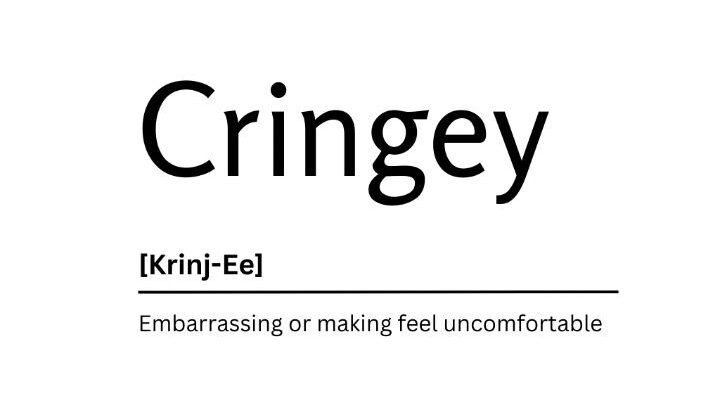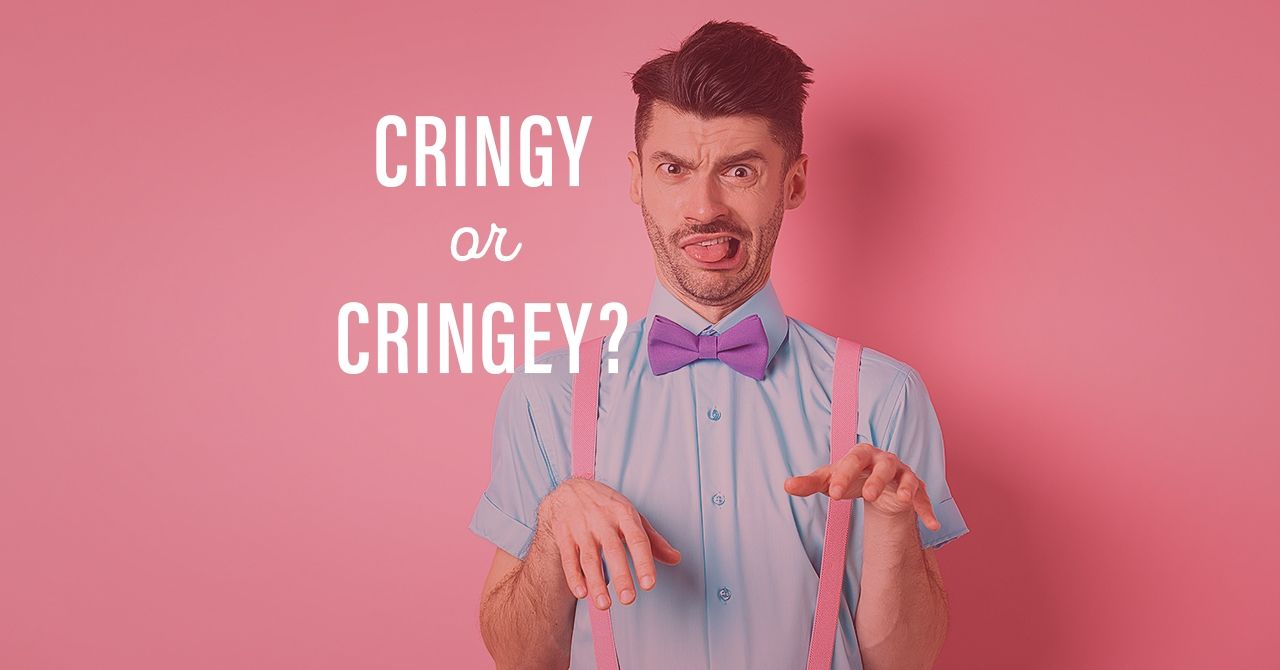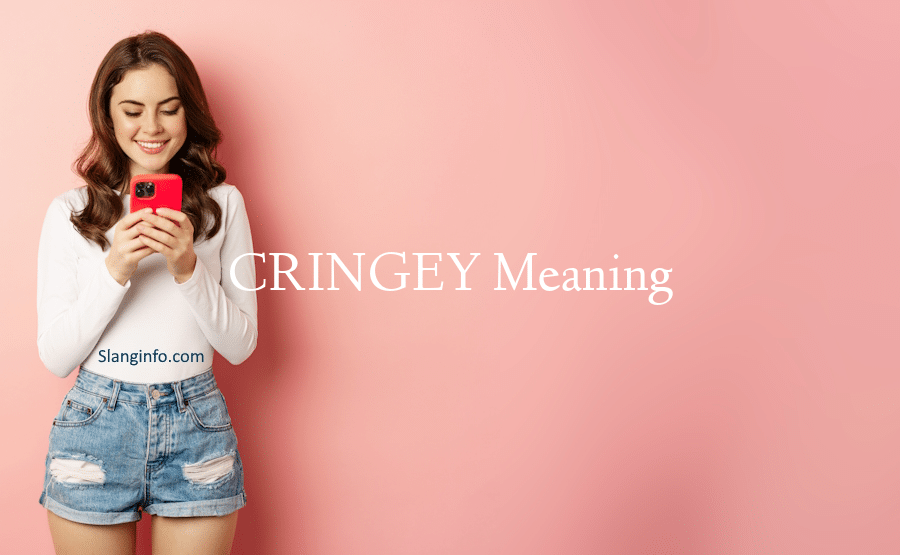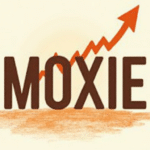Have you ever watched a video or witnessed a situation that made you want to curl up into a ball and disappear? That feeling of second-hand embarrassment or discomfort is often described as “cringe,” and when something consistently produces this reaction, we call it “cringey.” This popular slang term has become a staple in modern communication, especially online. But what exactly does cringey mean, and why has it become such a prevalent part of our cultural vocabulary?
| Key Takeaways |
|---|
| Cringey describes something embarrassing, awkward, or uncomfortable |
| The term originated from “cringe” and gained popularity through internet culture |
| Cringey content often involves social faux pas or attempts to be cool that fall flat |
| The perception of what’s cringey can vary based on age, culture, and personal experience |
| Understanding “cringey” can help navigate social situations and online interactions |

Definition of Cringey
“Cringey” (sometimes spelled “cringy”) is an adjective derived from the word “cringe.” It describes something that causes feelings of embarrassment, awkwardness, or discomfort, often to the point where you might physically cringe. Here’s a breakdown of its key aspects:
- Primary Meaning: Extremely embarrassing or awkward
- Emotional Response: Causes second-hand embarrassment or discomfort in observers
- Context: Often used to describe social interactions, media content, or attempts at humor that fall flat
- Usage: Commonly employed in casual conversation and online communication
For example, imagine a middle-aged teacher trying to use current slang to connect with students, but getting it all wrong. That situation would likely be described as cringey by many observers.
Evolution of the Term
The journey of “cringey” from a niche internet term to a widely used expression is fascinating:
- Origin: Derived from “cringe,” which has been in use since the 15th century
- Rise in Internet Culture: Gained popularity in the early 2010s on social media and forums
- Meme Culture: Became associated with “cringe compilation” videos and memes
- Mainstream Adoption: Entered everyday language, especially among younger generations
I remember first encountering “cringey” on Reddit around 2012. Users would share stories of awkward social interactions, labeling them as “cringey moments.” It wasn’t long before the term spread to other platforms and eventually into spoken language.
Usage in Different Contexts
“Cringey” has found its way into various aspects of our communication:
Social Media
- Describing awkward posts or oversharing
- Commenting on failed attempts at humor or relatability
Everyday Conversations
- Recounting embarrassing personal experiences
- Discussing uncomfortable social situations
Pop Culture References
- Critiquing out-of-touch advertising campaigns
- Describing certain character behaviors in movies or TV shows
Common Cringey Scenarios
- 😬 Public speaking mishaps
- 🎤 Off-key karaoke performances
- 🕺 Adults trying too hard to seem “cool” to younger people
- 📱 Overly personal or dramatic social media posts
- 🎭 Forced or inauthentic behavior in social situations
The Psychology Behind Cringe
Understanding why we find certain things cringey involves delving into human psychology:
- Empathy: We often cringe because we can imagine ourselves in the embarrassing situation.
- Social Norms: Cringe reactions are often triggered by violations of social expectations.
- Self-Reflection: Sometimes, cringey content reminds us of our own past embarrassments.
Dr. Melanie Tannenbaum, a social psychologist, explains:
“Cringe reactions are deeply rooted in our social nature. We’re hardwired to be aware of social norms and to feel uncomfortable when we see them being violated. This discomfort is a way our brains signal the importance of adhering to social rules.”
This psychological aspect of cringe explains why what’s considered cringey can vary significantly between cultures and generations. What’s cringey to one group might be completely normal or even cool to another.
For more insights into how language reflects our social dynamics, check out our article on Gen Z slang.
Cringe Culture
The concept of “cringe culture” has emerged alongside the popularization of the term “cringey.” This refers to the trend of sharing and mocking content deemed embarrassing or awkward. While it can be a way for people to bond over shared discomfort, it has also faced criticism:
Positive Aspects:
- Can help people recognize and avoid social faux pas
- Provides a way to process second-hand embarrassment through humor
Negative Aspects:
- May lead to cyberbullying or excessive mockery
- Can create anxiety about self-expression, especially in young people
It’s important to approach cringe culture with empathy and awareness. Remember, what’s cringey to you might be someone else’s genuine self-expression.
For more on how internet culture shapes our communication, take a look at our article on ROFL meaning.
Examples of Cringey Content
Cringey content comes in many forms, often reflecting current trends and social norms. Here are some common examples:
- Outdated Memes: Using memes that are no longer popular or relevant
- Forced Slang: Adults or brands using youth slang incorrectly or excessively
- Oversharing on Social Media: Posting extremely personal or inappropriate content
- Public Displays of Affection: Excessive or inappropriate PDA, especially on social media
- Failed Humor Attempts: Jokes that fall flat or are considered offensive
Notable Cringey Moments in Pop Culture
Some cringey moments have become infamous:
- Scott’s Tots Episode (The Office): Michael Scott’s unfulfilled promise to pay for college tuition
- Kendall Jenner’s Pepsi Ad: A tone-deaf commercial that trivialized social justice movements
- Rebecca Black’s “Friday”: A music video that became notorious for its perceived awkwardness
It’s worth noting that perceptions of cringe can change over time. What was once considered cringey might later be viewed with nostalgia or even admiration. For instance, some fashion trends from the early 2000s that were once deemed cringey are now making a comeback.
Impact on Social Behavior
The fear of being labeled “cringey” can significantly influence behavior, especially among younger people:
- Self-Censorship: People may hesitate to express themselves freely for fear of judgment
- Increased Social Anxiety: Worry about social missteps can lead to heightened anxiety in social situations
- Conformity Pressure: The desire to avoid being cringey might lead to excessive conformity to trends
Effects of “Cringey” on Social Behavior
| Behavior | Potential Impact |
|---|---|
| Self-Expression | Reduced authenticity, fear of sharing genuine interests |
| Social Media Usage | Overthinking posts, increased anxiety about online presence |
| Fashion Choices | Strict adherence to trends, fear of standing out |
| Public Speaking | Increased nervousness, avoidance of public speaking opportunities |
However, it’s important to recognize that the concept of “cringey” is subjective and often generational. What one group finds cringey, another might find endearing or cool. This subjectivity is evident in the cyclical nature of trends, where once-cringey styles or behaviors can come back into fashion.
Cringey in Marketing and Branding
Brands often walk a fine line between being relatable and being perceived as cringey. Here are some examples:
Successful Approaches:
- Wendy’s Twitter Account: Known for its witty and sometimes sarcastic tweets that resonate with younger audiences
- Old Spice Commercials: Embraced absurdist humor that appealed to a wide range of viewers
Unsuccessful Attempts:
- Microsoft’s “Hey Fellow Kids” Tweet: An attempt to connect with younger users that was widely mocked
- Pepsi’s Kendall Jenner Ad: A commercial that trivialized social justice movements and was quickly pulled after backlash
For brands, understanding the fine line between relatable and cringey is crucial. It often involves staying authentic to the brand’s voice while being aware of current trends and social contexts.
For more insights on how language trends affect communication, check out our article on LBVS meaning.
Overcoming the Fear of Being Cringey
While it’s natural to want to avoid embarrassment, an excessive fear of being cringey can be limiting. Here are some strategies to overcome this fear:
- Embrace Authenticity: Remember that genuine self-expression is often more appreciated than trying too hard to fit in
- Practice Self-Compassion: Be kind to yourself when you have cringey moments; everyone has them
- Reframe Perspective: Consider that what feels cringey to you might be endearing or relatable to others
- Focus on Growth: Use cringey moments as learning experiences rather than sources of shame
- Cultivate Resilience: Develop the ability to laugh at yourself and bounce back from embarrassing situations
Dr. Emma Seppälä, Science Director of Stanford University’s Center for Compassion and Altruism Research and Education, advises:
“Embracing your authentic self, even if it sometimes feels cringey, can lead to greater happiness and more meaningful connections. When we let go of the fear of judgment, we open ourselves up to genuine experiences and relationships.”
Remember, some of the most beloved public figures are those who aren’t afraid to be themselves, even if it sometimes results in cringey moments. Their authenticity often endears them to others more than a polished, “cringe-free” persona would.
For more on navigating social dynamics and communication, explore our article on SUS meaning.
The Future of Cringey
As language and social norms continue to evolve, so too will our understanding and use of the term “cringey.” Here are some predictions for its future:
- Evolving Definition: The specific behaviors or content considered cringey will likely shift with changing cultural trends.
- Generational Gaps: What’s cringey to one generation may become retro or cool to the next.
- Increased Self-Awareness: As discussions around cringe culture grow, people may become more self-aware about their reactions to “cringey” content.
- Digital Empathy: There might be a shift towards more empathy in online interactions, reducing the prevalence of cringe-shaming.
Predicted Trends in Cringe Culture
- 📊 Decreased use of “cringey” as a criticism
- 📊 Increased appreciation for authentic, “cringey” content
- 📊 More nuanced discussions about social awkwardness
- 📊 Integration of cringe awareness in digital literacy education
As we move forward, it’s likely that our relationship with “cringey” content will become more complex and nuanced. The internet’s ability to preserve moments indefinitely means that we’ll need to develop better ways of dealing with our past “cringey” selves and those of others.
Conclusion
“Cringey” has become a powerful term in our modern lexicon, reflecting our complex relationship with social norms, self-expression, and digital culture. While it can be a useful shorthand for describing uncomfortable or awkward situations, it’s important to use it mindfully and remember its subjective nature.
Key takeaways:
- “Cringey” describes something embarrassing or awkward that causes discomfort in observers.
- The term has evolved from internet slang to mainstream usage, reflecting changing social dynamics.
- Cringe reactions are rooted in empathy and awareness of social norms.
- Fear of being labeled “cringey” can impact behavior and self-expression, especially among young people.
- Embracing authenticity and developing resilience can help overcome the fear of being cringey.
As we navigate the ever-changing landscape of social media and digital communication, understanding the concept of “cringey” can help us approach interactions with more empathy and self-awareness. Remember, what’s cringey today might be celebrated tomorrow, and authentic self-expression often trumps the fear of judgment.
For more insights into modern communication and internet culture, check out our articles on BUSSIN meaning and GYAT meaning.

FAQs About Cringey
- Q: Is it spelled “cringey” or “cringy”?
A: Both spellings are acceptable, with “cringey” being slightly more common. - Q: Can something be intentionally cringey?
A: Yes, some content creators intentionally produce “cringey” content for comedic effect or to parody certain behaviors. - Q: Is calling something cringey a form of bullying?
A: It can be, especially if used repeatedly to shame or mock someone. It’s important to use the term thoughtfully. - Q: How can I tell if I’m being cringey?
A: Pay attention to others’ reactions and be open to feedback. Remember that what’s cringey to some might be charming to others. - Q: Can brands use cringey content effectively?
A: Yes, some brands successfully use self-aware “cringey” content to connect with audiences, often through humor or nostalgia.
By understanding the nuances of “cringey” and its impact on our social interactions, we can communicate more effectively and compassionately in our digital world. Whether you’re navigating social media, creating content, or just trying to understand the latest slang, being aware of the concept of “cringey” can help you engage more authentically with others.







